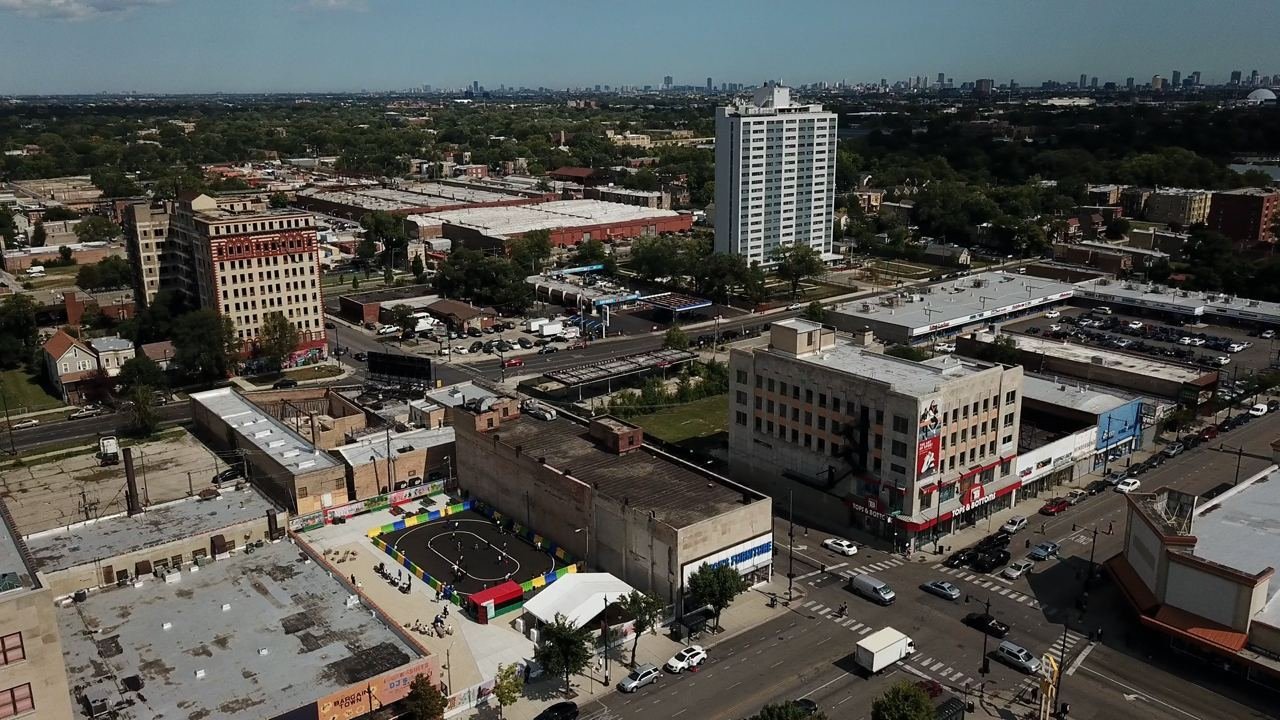Ushering in changes to West Garfield Park’s civic spaces, a process to tap into community expertise foregrounds the neighborhood’s new roller skating rink.
By Anjulie Rao
Photo: Studio Gang
In a once-vacant lot on Chicago’s West Side Garfield Park neighborhood, a new outdoor roller rink has made space for kids and adults alike to spend their summer days on eight wheels in a beloved Chicago pastime.
But the rink didn’t appear overnight; nine months prior to its opening, Studio Gang Architects—a firm known in Chicago for their iconic, undulating skyscrapers such as the Vista and Aqua Towers—were tapped to design a community engagement process that would work collaboratively with Garfield Park organizations and residents to generate ideas and feedback on the roller rink. Called the Neighborhood Activation pilot, the group’s process was guided by the city of Chicago’s Our City, Our Safety, a plan that focused on reducing the ‘safety gap’ in Chicago’s Black and Brown neighborhoods by activating vacant spaces. Studio Gang’s engagement process informed the roller rink’s design, which was completed by SITE Design Group.
According to firm founder Jeanne Gang, the roller rink is “one of a number of outcomes of our larger Neighborhood Activation project in West Garfield Park,” which include physical improvements to pedestrian infrastructure, tree plantings, and general beautification, as well as services like homeless outreach and violence prevention.
As important as the rink itself is the architecture firm’s forthcoming Neighborhood Action Playbook: a booklet that documents the firm’s community engagement process in Garfield Park that could serve as a best-practices manual for those seeking to replicate their methods in other communities. Gang talked about the successes and challenges of their community engagement process.
How did you involve the community in the engagement process?
Integrating community engagement into design has been a focus for about 10 years, as we’ve built our skills and knowledge through learning from expert collaborators and working on projects. Our specific ideas around how to use design to bridge between city government and community organizations started to gel in 2017, when we co-developed and facilitated a process in New York City. We evolved that process based on past experiences and lessons, and [tied in] the unique conditions and participants in West Garfield Park. Our work in Chicago was done in partnership with the Goldin Institute, who brought a series of complementary experiences and a local network.
How did you locate partner organizations?
We began by interviewing local leaders who had a history of organizing around neighborhood safety. We also went on a series of walking and biking tours with residents. Many of our first connections came through the Chicago Peace Fellows network, a program that supports the development of grassroots leaders focused on neighborhood safety in the South and West Sides. From these initial contacts, we were connected to others. Eventually, we created a sustained collaboration with the Garfield Park Rite to Wellness Collaborative (GPRWC). We also continued to invite organizations outside of GPRWC to participate in and direct the work.
How did you decide what types of activities—Zoom meetings, in-person meetings, online workshops—would be effective to solicit ideas and feedback?
We decided in partnership with Goldin Institute and GPRWC, who had deeper insight into the formats that would be most effective for each specific group. For a group of street-involved young men, it was important to come together in person. For a more general public meeting, it was effective to be on Zoom, live-drawing ideas on a digital white board. For some key stakeholders, it was important to stop by their workplace and interview them individually. For all groups, prior to vaccination, it was important to meet remotely, outside or in smaller groups.
What were some of the most effective—and least effective—activities to involve community members?
Live drawing in breakout sessions with a local facilitator was a successful exercise remotely or in person. We’ve found that drawing and taking visual notes enables participants to react to and build on each other’s ideas, which helps expedite consensus. Another especially successful part was holding a public groundbreaking for the roller rink that featured performers and speakers from the community, including those who were deeply involved in the process.
Less effective activities were phone conversations with residents or leaders of organizations that were conducted while they were engaged in other activities, which prevented them from being fully present or viewing any content to reflect on or respond to. Additionally, large town halls that did not have an express purpose often led to sprawling conversations with less clear direction or actionable next steps.
What were the main challenges you encountered in the process of working with the community?
The speed of trust and consensus were often in conflict with the project’s tight timeline. On one hand, a deadline can inspire more participation and expedite decision making. On the other, it can exclude those who aren’t available within the given time frame or need more time to work through the context before participating in discussions.
A major goal of the project, and a key measure of its success, is to enable local stakeholders to develop capacity, gather resources, and set efforts in motion that fuel momentum long after the designer’s participation. Physical and programmatic investments like the roller rink can catalyze participation, future investment, and action. Preparing for and facilitating this transition of responsibility, skills, and project management is challenging, but for us, it is crucial.
This story is available to republish under a Creative Commons license. Read City Bureau’s guidelines here.
Support City Bureau’s community-centered reporting by becoming a City Bureau sustaining donor today.
To get twice-monthly emails including Chicago news and events, sign up for City Bureau’s Chicago newsletter.

